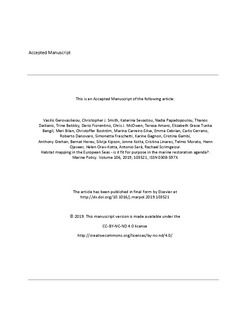| dc.contributor.author | Gerovasileiou, Vasilis | |
| dc.contributor.author | Smit, Christopher J | |
| dc.contributor.author | Sevastou, Katerina | |
| dc.contributor.author | Papadopoulou, Nadia | |
| dc.contributor.author | Dailianis, Thanos | |
| dc.contributor.author | Bekkby, Trine | |
| dc.contributor.author | Fiorentino, Dario | |
| dc.contributor.author | McOwen, Chris J. | |
| dc.contributor.author | Amaro, Teresa | |
| dc.contributor.author | Bengil, Elizabeth Grace Tunka | |
| dc.contributor.author | Bilan, Meri | |
| dc.contributor.author | Boström, Christoffer | |
| dc.contributor.author | Carreiro-Silva, Marina | |
| dc.contributor.author | Cebrian, Emma | |
| dc.contributor.author | Cerrano, Carlo | |
| dc.contributor.author | Danovaro, Roberto | |
| dc.contributor.author | Fraschetti, Simonetta | |
| dc.contributor.author | Gagnon, Karine | |
| dc.contributor.author | Gambi, Cristina | |
| dc.contributor.author | Grehan, Anthony | |
| dc.contributor.author | Hereu, Bernat | |
| dc.contributor.author | Kipson, Silvija | |
| dc.contributor.author | Kotta, Jonne | |
| dc.contributor.author | Linares, Cristina | |
| dc.contributor.author | Morato, Telmo | |
| dc.contributor.author | Ojaveer, Henn | |
| dc.contributor.author | Orav-Kotta, Helen | |
| dc.contributor.author | Sarà, Antonio | |
| dc.contributor.author | Scrimgeour, Rachael | |
| dc.date.accessioned | 2020-02-04T07:20:44Z | |
| dc.date.available | 2020-02-04T07:20:44Z | |
| dc.date.created | 2019-07-23T22:41:27Z | |
| dc.date.issued | 2019 | |
| dc.identifier.citation | Marine Policy. 2019, 106, 103521. | nb_NO |
| dc.identifier.issn | 0308-597X | |
| dc.identifier.uri | http://hdl.handle.net/11250/2639428 | |
| dc.description | Embargo until 21 May 2021 | nb_NO |
| dc.description.abstract | As habitat mapping is crucially important for developing effective management and restoration plans, the aim of this work was to produce a census of available map resources at the European scale focusing on: a) key marine habitats; b) degraded habitats; c) human activities and pressures acting on degraded habitats, and d) the restoration potential of degraded habitats. Almost half of the 580 map records were derived from grey literature and web resources but contained no georeferenced files for download, thus limiting further use of the data. Biogeographical heterogeneity was observed and varied between the type and quality of information provided. This variability was mainly related to differences in research efforts and stakeholder focus. Habitat degradation was assessed in only 28% of the map records and was mostly carried out in a qualitative manner. Less than half of the map records included assessments on the recovery/restoration potential of the degraded habitats, with passive restoration by removal of human activities being the most commonly recommended measure. The current work has identified several gaps and challenges both in the thematic and geographic coverage of the available map resources, as well as in the approaches implemented for the harmonized assessment of habitat degradation. These should guide future mapping initiatives in order to more comprehensively support and advise the marine habitat restoration agenda for better meeting the objectives set in relevant policy documents and legislative acts in Europe. | nb_NO |
| dc.language.iso | eng | nb_NO |
| dc.publisher | Elsevier | nb_NO |
| dc.rights | Attribution-NonCommercial-NoDerivatives 4.0 Internasjonal | * |
| dc.rights.uri | http://creativecommons.org/licenses/by-nc-nd/4.0/deed.no | * |
| dc.title | Habitat mapping in the European Seas - is it fit for purpose in the marine restoration agenda? | nb_NO |
| dc.type | Journal article | nb_NO |
| dc.type | Peer reviewed | nb_NO |
| dc.description.version | acceptedVersion | nb_NO |
| dc.source.pagenumber | 10 | nb_NO |
| dc.source.volume | 106 | nb_NO |
| dc.source.journal | Marine Policy | nb_NO |
| dc.identifier.doi | 10.1016/j.marpol.2019.103521 | |
| dc.identifier.cristin | 1712534 | |
| dc.relation.project | EC/H2020/689518 | nb_NO |
| cristin.unitcode | 7464,20,11,0 | |
| cristin.unitname | Marin biologi | |
| cristin.ispublished | true | |
| cristin.fulltext | postprint | |
| cristin.qualitycode | 1 | |

